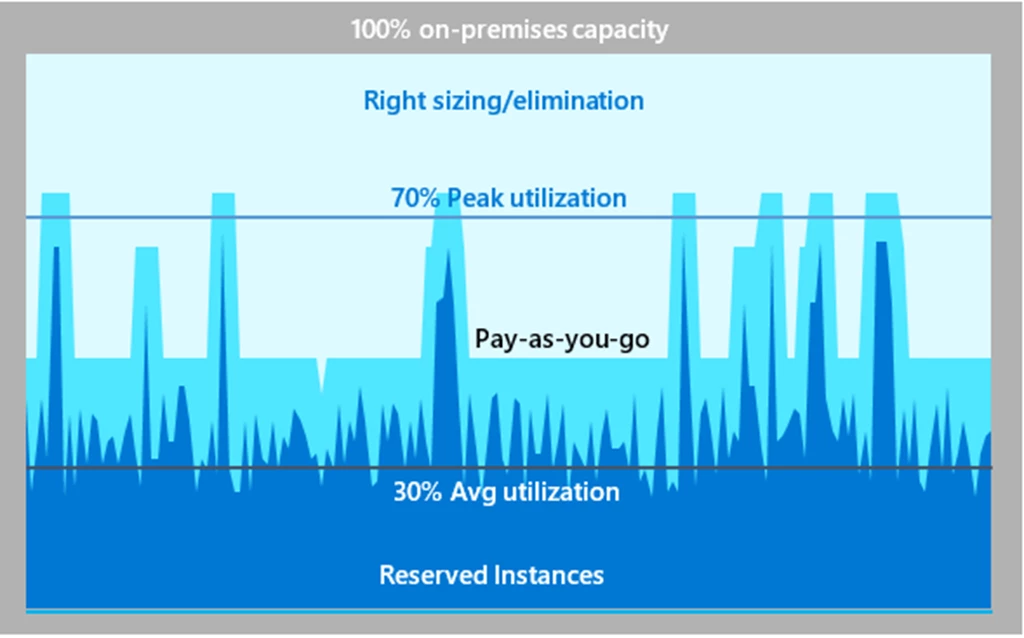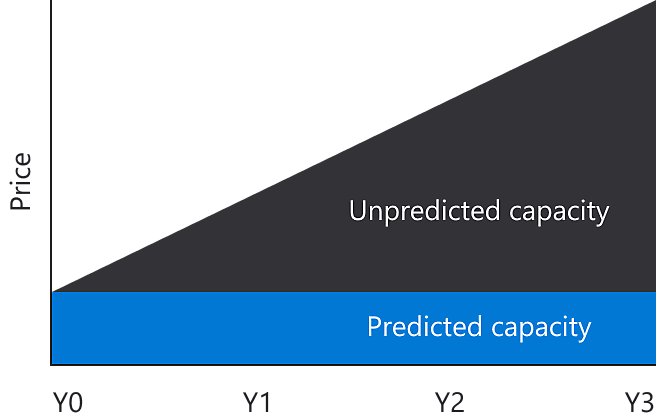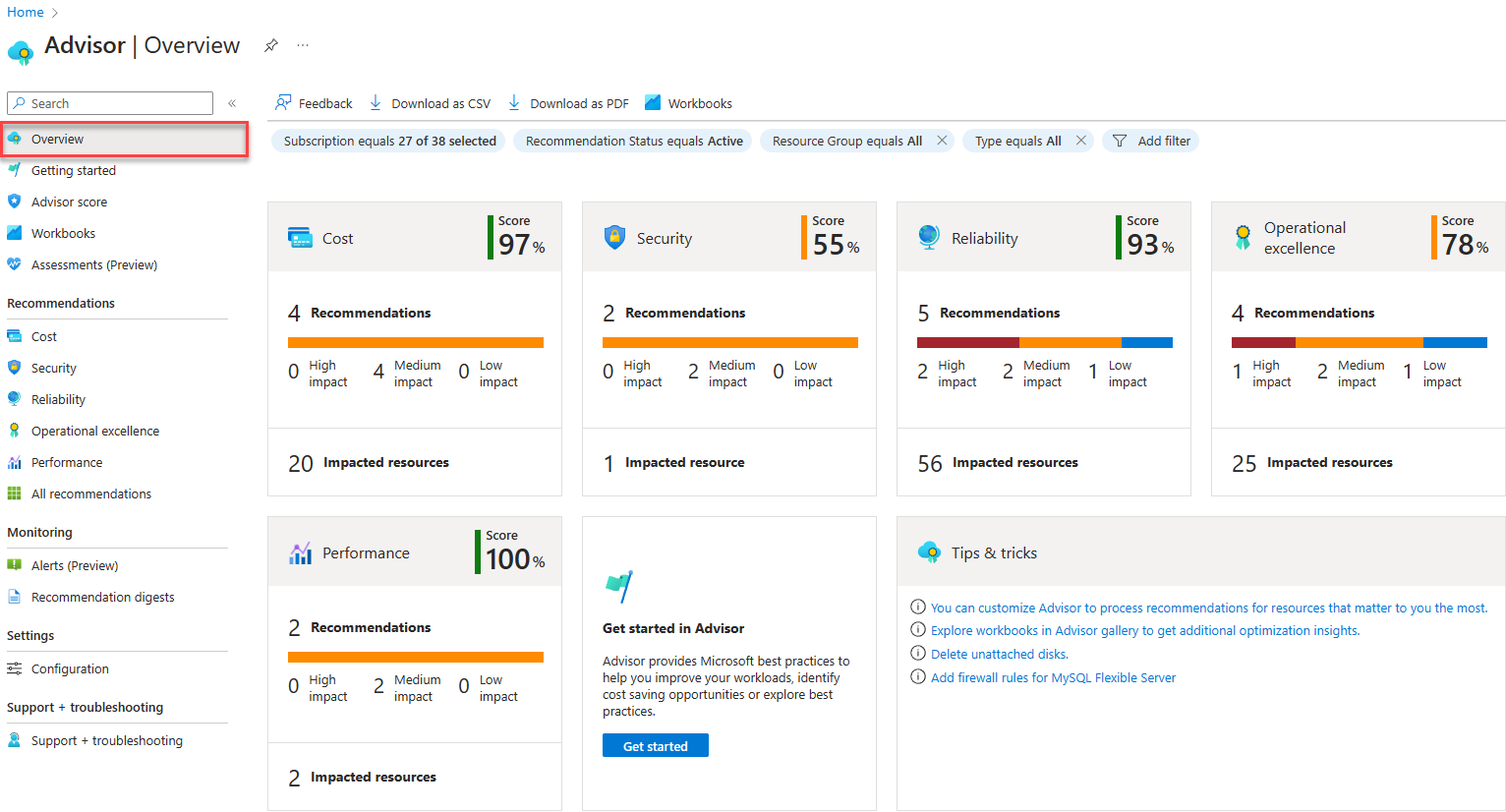Contents
You might be wondering, “How can I ensure cost-effectiveness without compromising performance or agility?” or “Where do I even begin with Azure cloud cost optimization?” Well, we’ve got your back!
As per the Flexera 2023 State of the Cloud report, optimizing existing cloud usage for cost savings remains the top initiative for the seventh consecutive year, highlighting the importance of efficient cost management in cloud environments.
In today’s fast-paced tech world, businesses are quickly adopting cloud technologies to enhance their agility, scalability, and overall performance. Azure, Microsoft’s flagship cloud service, is at the heart of this shift, offering a vast array of tools and features. Yet, for many, the challenge lies in leveraging Microsoft Azure‘s potential in a cost-effective manner without sacrificing efficiency.
Whether you’re a cloud architect, DevOps engineer, or a business decision-maker, mastering cloud cost optimization becomes a necessity. It makes the difference between a well-oiled, cost-effective cloud strategy and a financial black hole.
This is where RedBlink steps in. As pioneers in software development, we specialize in demystifying the complexities of Azure, ensuring that you harness its full power while keeping costs in check. Our expertise not only simplifies your cloud journey but also turns it into a strategic advantage for your business.
In this comprehensive guide to Azure Cost Optimization, we’ll explore its most effective strategies, from automating cost management to leveraging cost-saving programs and pricing models. Cloud cost optimization blends cost management, carbon footprint reduction, and energy optimization, ensuring that your applications run efficiently, sustainably, and at the lowest possible expense.
Signs You Need Azure Cost Optimization
We’re here to help you identify the signs that you need to optimize your Azure costs. Recognizing these signs early and taking action can prevent budget overruns and ensure your Azure investment is as efficient and effective as possible.
- Spiraling Cloud Expenses: If your Azure bills are consistently higher than anticipated, indicating a trend of escalating costs, it’s a clear sign that your cloud spend needs a thorough review and optimization.
- Underutilized Resources: Detecting resources with low utilization rates suggests you’re paying for more than you actually need. Optimizing these can significantly reduce costs.
- Complex Billing Statements: Difficulty in understanding your Azure billing statements could point to complex, possibly unnecessary services adding to your costs.
- Overprovisioning: Setting up more capacity than required, a common mistake, leads to wasted resources and higher expenses.
- Lack of Budgeting and Forecasting: Struggling to predict future costs or adhere to a budget indicates the need for a more strategic approach to your Azure resources.
- Unmanaged Scalability: If your environment scales automatically without cost controls, you may end up with a hefty bill for resources you didn’t intend to use extensively.
- Inefficient Resource Allocation: Utilizing expensive resources for tasks that could be handled by more cost-effective options is a sure sign of inefficient spending.
- Ignoring Reserved Instances: Not taking advantage of Azure Reserved Instances or Savings Plans for consistent workloads can lead to missed savings opportunities.
- Limited Visibility into Spending: Without clear insight into where and how your budget is being spent, pinpointing areas for cost reduction becomes a challenge.
If any of these signs resonate with your organization’s Azure cloud journey, it’s time to embrace cost optimization as an essential component of your cloud strategy.
We know it’s not always easy, but trust us, your future self (and your wallet) will thank you.
Azure Cloud Cost Optimization Best Practices in 2024
By meticulously implementing these strategies, businesses can ensure they’re not overpaying for the cloud services they consume, thus maximizing their return on investment in Azure. Additionally, incorporating cost-effective measures like identifying idle resources and shutting them down or scaling them back, opting for budget-friendly storage options, and optimizing network configurations to avoid unnecessary data transfer fees are crucial.
Establishing governance policies that enforce best practices in resource deployment and usage across teams also plays a significant role in controlling costs. Ultimately, Azure Cloud Cost Optimization is not just about cutting expenses but about making smart, informed decisions that drive operational efficiency, foster innovation, and support the scalable growth of your business in the cloud.
1. Effective Monitoring and Reporting Strategies for Azure Cost Optimization
Achieving end-to-end cost visibility and continuous monitoring is essential for identifying optimization opportunities and staying on top of your cloud spending.
-
Automated Azure Monitoring
We should aim to implement processes that provide end-to-end visibility into cloud expenditure, from individual resources to overall cost breakdowns by service, application, or business unit.
Azure Cost Management + Billing, combined with Azure resource tagging, can give us granular insights into our cloud costs, enabling data-driven decision-making and targeted optimization efforts.
By automating cost visibility, we’ll have real-time access to accurate cost data, eliminating the need for manual data collection and analysis.
-
Implement Continuous Cost Optimization in Azure
Cost optimization isn’t a one-time effort; it’s an ongoing process that requires continuous monitoring and adjustment. We should implement automated monitoring solutions to track our Azure costs consistently, identify anomalies or inefficiencies, and promptly take corrective actions.
Azure Advisor and Azure Cost Management’s budget and cost alerts can notify us when costs exceed predefined thresholds or deviate from expected patterns. By continuously monitoring our costs, we can proactively address issues before they escalate, ensuring our cloud spending remains under control.
-
Decode Your Azure Expenditure
While having visibility into our costs is crucial, we should also strive to understand the underlying drivers of our cloud expenditure. We need to analyze our cost data to identify the specific services, resources, or workloads that contribute most to our overall Azure bill.
-
Leverage Real-Time Anomaly Detection and Cost Alerts
In addition to continuous monitoring, we should leverage real-time cost anomaly detection and alerting capabilities. Anomaly detection can identify unusual spending patterns or cost spikes, alerting us promptly.
By setting up real-time alerts, we can quickly respond to cost anomalies, investigate the root causes, and take immediate action to mitigate potential cost overruns.
This proactive approach helps us stay ahead of unexpected cost increases, ensuring our cloud spending remains under control and aligned with our budgets.
By automating these processes, we can stay vigilant, proactively identify optimization opportunities, and keep our cloud spending in check – something we can’t afford to ignore in today’s dynamic cloud environment.
2. Automating Azure Cost Management for Efficiency and Savings
In today’s fast-paced cloud environment, we can’t afford to rely on manual cost management processes – they simply won’t cut it if we want to stay ahead. Embracing automation is necessary for streamlining our cost optimization efforts, and we feel it’s key to ensuring consistent, scalable, and proactive cost control across all Azure deployments.
-
The Role of Automation in Azure Cloud Management
We should automate tasks like resource provisioning, decommissioning, rightsizing, and scheduling, as it can significantly reduce human error risks and optimize resource utilization – something we don’t take lightly. It is an important step and getting expert help is the ideal solution to speed up things without indulging in technical stuff.
-
Strategic Resource Tagging for Optimized Azure Cost Tracking
Effective cost management starts with proper resource organization and visibility. Azure resource tagging allows us to categorize and label resources based on criteria like environment, application, or cost center. Implementing a consistent tagging strategy gains us granular insights into cloud costs, enabling accurate cost allocation, chargeback, and targeted optimization efforts.
Follow this link to know how to Apply tags with Azure portal?
-
Optimize Azure VM Utilization Through Smart Scheduling
Virtual machines are often one of the largest cost drivers in an Azure environment, which we can’t ignore. To optimize VM costs, aligning their start/stop schedules with actual usage patterns is crucial.
We should leverage Azure Automation runbooks to automatically start and stop VMs based on schedules or triggers, ensuring resources only run when needed and reducing unnecessary idle time and costs.
Steps to Automate Shutdown and Auto-Start of Azure VMs
-
Shutdown of Idle Azure Resources
We need to implement automated processes to identify and shut down idle or unused resources like dev/test environments, expired VMs, or orphaned storage accounts, as they can quickly drain our cloud budget without providing value – something we don’t want.
-
Enhance Scalability with Azure VM Autoscaling
In environments with fluctuating workloads, we should embrace Azure Virtual Machine Scale Sets and configurable autoscaling rules to automatically scale our VM instances based on demand.
Manual scaling is time-consuming and can often lead to over-provisioning or performance bottlenecks – a scenario we want to avoid – so autoscaling ensures optimal resource utilization and cost-effectiveness.
Automating cost management processes reduces human error risks and gives us the agility and scalability needed to stay ahead of changing cost dynamics.
| Metric Source | Use Case | Valuable Addition |
|---|---|---|
| Current Scale Set | For host-based metrics that do not require additional agents to be installed or configured. | Enables real-time scaling decisions based on VM performance and load, optimizing resource usage and cost. |
| Storage Account | The Azure diagnostic extension writes performance metrics to Azure storage, which is then consumed to trigger autoscale rules. | Provides a durable storage solution for logging and analyzing long-term performance trends, aiding in forensic analysis and predictive scaling strategies. |
| Service Bus Queue | Your application or other components can transmit messages on an Azure Service Bus queue to trigger rules. | Facilitates communication between distributed application components, allowing for scalable, event-driven architectures that can automatically adjust to varying workloads. |
| Application Insights | An instrumentation package installed in your application that streams metrics directly from the app. | Offers deep insights into application performance and user behavior, enabling targeted optimizations and improved user experiences through direct application telemetry. |
3. Optimizing Azure Resources for Cost Efficiency

Ensuring our resources are sized correctly and utilizing the right services can significantly reduce our cloud expenditure.
-
Optimizing Azure Deployments Through Resource Rightsizing
One of the most effective ways to optimize our Azure costs is by rightsizing underutilized resources. We’ve all been there – provisioning resources with more capacity than we need, leading to wasted spending. In our opinion, it’s crucial to continuously monitor resource utilization and adjust sizing accordingly.
By downsizing these resources to match our actual workload requirements, we can reduce our monthly costs while maintaining optimal performance.
-
Leveraging Azure Elastic Databases for Scalable Cost Optimization
If our workloads involve databases with fluctuating usage patterns, we should consider switching to Azure Elastic Databases. These databases can scale resources up or down automatically based on demand, ensuring we pay only for the capacity we need at any given time.
Azure Elastic Databases can help us avoid over-provisioning and reduce costs associated with idle or underutilized database resources.
-
Utilizing Azure’s Storage Tiering Capabilities
Azure Storage offers various tiers with different performance and cost characteristics. We should take advantage of storage tiering to optimize our costs based on our data access patterns and durability requirements.
For frequently accessed data, we can utilize the high-performance Premium Storage tier, while for less frequently accessed or archival data, we can leverage the cost-effective Cool or Archive tiers. By aligning our storage needs with the appropriate tiers, we can optimize costs without compromising on performance or availability.
-
Reducing Development Costs with Azure’s Dev-Test Pricing Models
If we’re running development or testing workloads in Azure, we shouldn’t overlook the cost-saving benefits of Azure Dev-Test Pricing. This pricing model offers significant discounts on various Azure services, such as virtual machines, databases, and storage, when used for non-production purposes.
By taking advantage of Azure Dev-Test Pricing, we can substantially reduce the costs associated with our development and testing environments, freeing up resources for other business-critical workloads.
This proactive approach empowers us to maximize resource utilization, minimize waste, and ultimately, optimize our cloud spending – something that should be a top priority for any organization operating in the cloud.
Calculate your estimated hourly or monthly costs for using Azure
4. Leveraging Azure’s Cost-Saving Programs and Flexible Pricing Models
Microsoft Azure offers various programs and pricing models designed to help us reduce our cloud costs significantly. Leveraging these options effectively can unlock substantial savings and optimize our Azure expenditure.
-
Maximizing Savings with Azure Hybrid Benefit
If we have existing Windows Server or SQL Server licenses, we shouldn’t miss out on the Azure Hybrid Benefit. This program allows us to bring our on-premises license investments to the cloud, enabling us to pay only the base compute rate for Azure virtual machines running Windows Server or SQL Server.
By taking advantage of the Azure Hybrid Benefit, we can potentially save up to 40-50% on virtual machine costs, making it a compelling option for organizations looking to maximize their existing software investments while migrating to the cloud.
Resources
SQL Server 2019 licensing guide
-
Strategic Planning with Azure Reservations

For workloads with predictable and consistent resource requirements, we should consider Azure Reservations. These allow us to pre-pay for Azure resources (such as virtual machines, databases, or storage) for one or three years, offering significant discounts compared to pay-as-you-go pricing.
By committing to long-term resource usage and leveraging Azure Reservations, we can save up to 72% on our Azure costs. This pricing model is particularly beneficial for steady-state production workloads or environments with predictable capacity requirements.
-
How Azure Savings Plans Transform Cloud Finances?
| Usage Compared to Hourly Amount | How You’re Billed |
|---|---|
| Equal to or Less Than | Enjoy reduced prices with the savings plan- You’re billed for the full hourly rate, even if you use less – No extra fees as your usage is within the plan’s coverage. |
| More Than | The part of your usage that matches the hourly rate is still billed at the savings plan’s lower prices – Any use beyond the hourly rate is charged at regular pay-as-you-go rates. |
For organizations with more dynamic or unpredictable computing requirements, Microsoft offers Azure Savings Plans for Compute. These plans allow us to pre-pay for a committed amount of compute usage over a one or three-year term, providing discounts of up to 65% compared to pay-as-you-go pricing.
Azure Savings Plans for Compute offer flexibility, as the committed usage can be applied across various Azure compute services, such as Virtual Machines, Container Instances, and Azure Kubernetes Service (AKS). This pricing model can be particularly advantageous for organizations with fluctuating computing needs across multiple workloads.
The latest feature added to Microsoft Azure cloud is Kube-Reserved Resource Optimization. This feature in Azure Kubernetes Service (AKS) improves resource reservation algorithms, reducing memory requirements by up to 20%.
-
Leveraging Azure Price Matching to Your Advantage
If we find a lower price for a comparable cloud service from another major cloud service provider, we can leverage Azure’s Price Matching program to request a matching price from Microsoft. This program helps ensure we get the best possible value for our Azure services, without compromising on quality or functionality.
By taking advantage of Azure Price Matching, we can potentially reduce our cloud costs and stay competitive, while continuing to benefit from the robust features and capabilities of the Azure platform.
-
Geographical Arbitrage in Azure
Azure’s pricing can vary across different regions, reflecting factors such as data center operational costs and local market conditions. We should carefully evaluate the regional pricing differences and consider deploying our workloads in regions with lower prices, where feasible.
While regional pricing differences may seem relatively small, they can add up significantly for large-scale deployments or long-running workloads. By optimizing our resource distribution across regions, we can potentially realize substantial cost savings without sacrificing performance or availability.
These strategies empower us to maximize the value of our Azure investments while minimizing unnecessary spending.
5. Implementing Governance and Best Practices for Azure Cost Optimization
Establishing sound governance frameworks and adhering to best practices is compulsory for ensuring long-term cost efficiency and maintaining control over your Azure expenditure.
-
Strategic Trade-offs in Azure Cost Optimization
When it comes to cloud cost optimization, there’s rarely a one-size-fits-all solution. We need to carefully evaluate the various options available and understand the potential tradeoffs involved. For example, while scaling down resources can reduce costs, it may also impact performance or availability.
In our opinion, it’s essential to strike the right balance between cost savings and operational requirements. We should thoroughly analyze our workload characteristics, performance needs, and business priorities to make informed decisions about which cost optimization strategies to implement and where to focus our efforts.
-
Leveraging Azure Advisor for Intelligent Cost Management

Microsoft Azure Advisor is a powerful built-in tool that can be a game-changer for our cost optimization efforts. Azure Advisor continuously analyzes our Azure deployments and provides personalized recommendations for optimizing costs, improving security, and enhancing operational excellence.
By leveraging Azure Advisor’s cost recommendations, we can identify underutilized resources, rightsizing opportunities, and potential areas for cost savings. Additionally, Azure Advisor can help us enforce best practices, ensuring our Azure resources are configured optimally and aligned with Microsoft’s recommended guidelines.
Advisor dashboard overview –
- At the top, you’ll find links for:
- Providing Feedback.
- Downloading recommendations in CSV or PDF formats.
- Accessing Advisor Workbooks directly via a quick link.
- Blue filter buttons beneath these links help narrow down the recommendations.
- The interface features tiles for each recommendation category, displaying your current score within that category.
- Clicking the “Get started” link directs you to:
- Advisor workbooks.
- Recommendations.
- The main page of the Well Architected Framework.
-
Optimizing Cloud Costs with Azure Policy: Effective Strategies
While Azure Advisor provides valuable recommendations, Azure Policy allows us to take proactive control over our cloud costs. Azure Policy is a governance tool that enables us to create, assign, and enforce policies across our Azure resources, ensuring compliance with defined rules and standards.
We can leverage Azure Policy to implement cost control measures, such as restricting the creation of resources in specific regions, enforcing resource tagging conventions, or preventing the deployment of non-compliant or excessively costly resource configurations. By establishing and enforcing cost-conscious policies, we can proactively prevent cost overruns and maintain a consistent, cost-effective Azure environment.
Implementing sound governance practices not only helps us optimize our Azure costs but also ensures long-term cost predictability, compliance, and alignment with our organization’s broader cloud strategy.
As Azure users, we understand the importance of optimizing our cloud costs to maximize our return on investment. While all the above-discussed strategies for optimizing Azure costs prove useful, sometimes it makes sense to bring in Microsoft cloud cost optimization experts who can help us get the most out of our cloud investment.
Here, we’ll explore the benefits of hiring cloud cost optimization experts like RedBlink Technologies and why they can be a valuable asset for our business.
Choosing RedBlink for Expert Cloud Cost Optimization Solutions
Hiring cloud cost optimization experts can help businesses extract the maximum value from Azure investment. These professionals possess the skills and expertise required to assess our cloud infrastructure, identify areas of inefficiency, and implement cost-saving strategies. They can help us:
- Assess our current Azure setup: Cloud cost optimization experts can review our current Azure configuration and identify areas where we can optimize costs. They can examine our resource utilization, billing structure, and other factors to determine where improvements can be made.
- Implement cost-saving strategies: Based on their assessment, cloud cost optimization experts can suggest and implement various cost-saving strategies tailored to our specific needs. These strategies may include reserved instances, spot instances, autoscaling, and rightsizing, among others.
- Provide ongoing support and maintenance: Cloud cost optimization experts can provide ongoing support and maintenance to ensure that our Azure costs remain optimized. They can monitor our cloud usage, detect anomalies, and perform regular audits to ensure that we are getting the best value from our Azure investment.
A Closer Look at Our Cloud Cost Optimization Excellence
Hiring cloud cost optimization experts can be a game-changer for businesses looking to maximize their Azure cloud investments. These seasoned professionals bring invaluable expertise and a deep understanding of Azure’s intricate pricing models, cost-saving programs, and optimization strategies. By leveraging their specialized knowledge, businesses can unlock significant cost savings while ensuring optimal resource utilization and performance.
Moreover, cloud cost optimization is a complex and ever-evolving domain, requiring continuous monitoring, analysis, and adaptation. With their finger on the pulse of the latest trends and best practices, cloud cost optimization experts like us can provide customized solutions tailored to each organization’s unique needs. This personalized approach not only delivers tangible cost reductions but also frees up valuable time and resources, allowing businesses to focus on their core competencies and strategic initiatives.
Wrapping Up
Optimizing cloud costs is crucial for maximizing the return on investment from your Azure deployment. Hiring dedicated cloud cost optimization experts can significantly benefit your organization by ensuring efficient resource utilization, implementing cost-saving strategies, and providing ongoing support and maintenance.
With specialized expertise, cloud cost optimization experts from RedBlink Technologies can thoroughly assess your current Azure setup, identify areas for improvement, and implement tailored solutions to reduce unnecessary expenses. We can help you right-size resources, optimize storage and network configurations, leverage cost-effective pricing models, and implement automation to streamline processes.
Don’t let inefficiencies drain your budget. Take control of your Azure costs today by partnering with RedBlink Technologies, a leading provider of Microsoft Azure cloud cost optimization services. Contact us now to schedule a consultation and discover how our experts can help you maximize the value of your Azure investment while minimizing unnecessary expenses.
Azure Cost Optimization Queries Answered
Q1. How does Azure Hybrid Benefit reduce costs?
Ans – Azure Hybrid Benefit reduces costs by allowing you to use existing Windows Server and SQL Server licenses on Azure VMs, significantly cutting down on cloud expenses.
Q2. Can Azure Cost Management tools predict future expenses?
Ans – Yes, Azure Cost Management tools can forecast future spending by analyzing historical usage patterns, helping with budget planning.
Q3. What are Azure Spot VMs and how do they save money?
Ans – Azure Spot VMs offer unused Azure computing capacity at discounted rates. They’re cost-effective for flexible, interruptible workloads.
Q4. Is there a benefit to using Azure Reserved Instances for all workloads?
Ans – Reserved Instances save money for steady, predictable workloads but may not be cost-effective for variable or short-term tasks.
Q5. How do auto-scaling settings contribute to cost optimization?
Ans – Auto-scaling adjusts resources based on demand, ensuring you pay only for what you use, optimizing costs without sacrificing performance.
Additional Resources

Director of Engineering | CTO | Software Developer
As a passionate technologist and seasoned software developer, I specialize in creating innovative solutions at the intersection of AI and software engineering. With a keen interest in leveraging the latest technologies to solve real-world problems, my work spans developing advanced AI models to designing scalable software architectures. Beyond coding, I contribute to tech blogs, sharing insights on AI trends, software best practices, and the future of technology. My mission is to empower organizations and individuals through technology, driving forward the boundaries of what’s possible
